EGYPTOLOGY: Akhenaten – Rebellious Ruler of Ancient Egypt
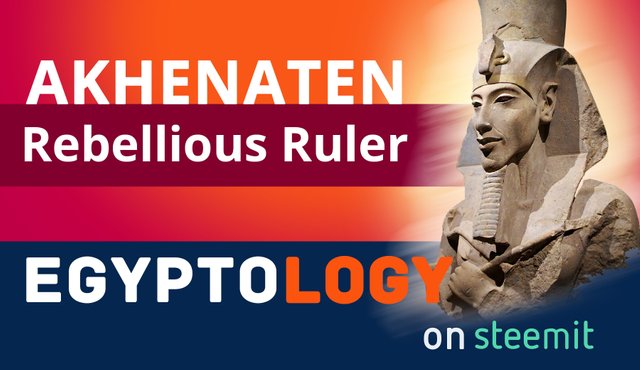
Dear readers, I arrived in Egypt for doing research about lions and sphinxes in the oases of the western desert. Therefore I will visit special sites and ancient ruins for making photographs of the statues and images on temple walls. Until I can give you a detailed insight into my work, I kindly ask you for some patience. In the meanwhile, I wanna tell you something about one of the most controversial rulers in Ancient Egypt: Pharao Amenhotep IV, also known as Akhenaten.
Born as a Prince
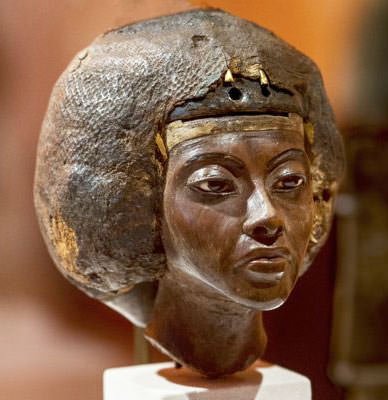 Img 1: Queen Tiye, the mother of Akhenaten, Berlin Museum
Img 1: Queen Tiye, the mother of Akhenaten, Berlin MuseumDuring his childhood Akhenaten was educated on a high level. He learned how to read and write. Beside this the royal children were deeply introduced into the religion. So Akhenaten was raised with a polytheistic worldview. This means there were many Gods known for several purposes with the God Re, the "creator", as the main God. For every phenomenon, may it has had a natural cause or was something that couldn't be explained so far, the Ancient Egyptians had a special deity. Hapi, for example, was the God of the annual flooding and was worshipped to ask for the flood not to be destructive. At the tip of the Ancient Egyptian pantheon in the time of Akhenaten's childhood, there was the God Amun, that actually means "the hidden one" or "the secret one".
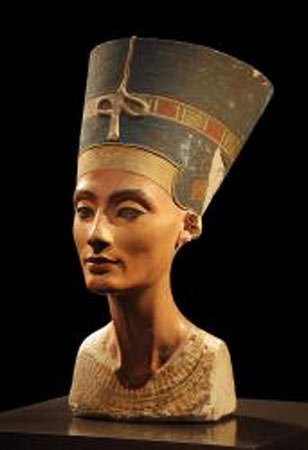
Img 2: Bust of Nefertiti, Berlin Museum
The Creation of a New God
In the years 1350–1348 Akhenaten built a great temple that was dedicated to a completely new deity – the God Aten. The naming of the God was also absolutely unique at that time. It contained a long list of a "program" the new God came with: "Re-Harachte, who is rejoicing at his horizon in His name as the light, that is Aten." The word "Aten", derived from the Middle-Egyptian word itn and means "cosmos" and stands also for the symbol of the sun disk in which the Sun God is residing. Here you can see that the idea of a Sun God is not new, but his appearance changed. Now there was no Sun God in the shape of a human with an animal head or similar anymore. Aten presented himself as "the light" of the sun. Where there was sunlight, there was Aten. The new God did not talk or act like the previous Gods in the pantheon. Only Akhenaten himself became the "voice" of Aten.
Akhenaten himself wrote the so-called Aten Hymn to embrace the new God. In the following I quote a few lines from it:
"How manifold it is, what thou hast made!
They are hidden from the face (of man).
O sole god, like whom there is no other!
Thou didst create the world according to thy desire,
Whilst thou wert alone: All men, cattle, and wild beasts,
Whatever is on earth, going upon (its) feet,
And what is on high, flying with its wings."
Translation by James B. Pritchard
Immediately after the Pharao's decision, everything had to be changed in temples and religious schools. It was some kind of a revolution within the spiritual mind, but you can imagine – not everyone was "amused" about that. Especially the priesthood of the "old" Amun temples. It's likely that in the moment, Akhenaten started his new religious dogma he caused a rage against him that grew secretly in the underground...
The New Capital
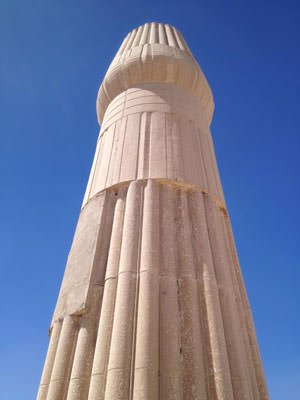
Img 3: Column of the Great Temple of Aten
Tell el-Amarna (original Egyptian name 3ḫ.t-Itn = "Akhet Aten" = The Horizon of Aten) is the name of the city chosen by Akhenaten to be the royal residence and the new capital of Egypt during his reign. Today you can visit this place, which is located in the Al Minya district 300 km south of Cairo. It's an open-air museum, but there is not much left from the former Great City of Aten. Rests of the huge palace and the temple are still visible and give at least a clue of what happened thousands of years ago.
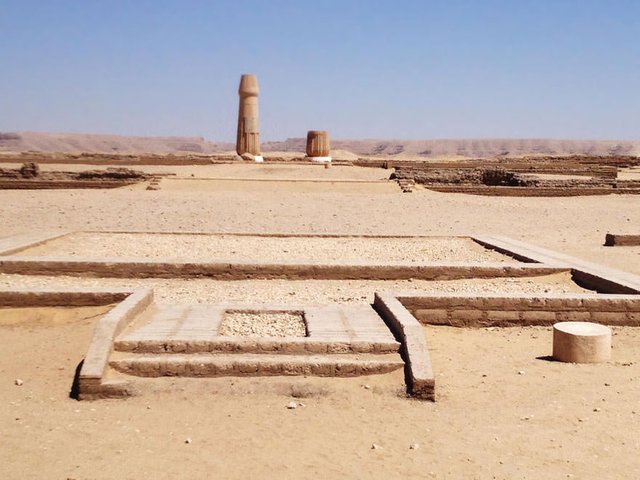
On the upper picture, which I took 2 years ago, you can see white stonework on the bottom of the pillars. This is part of the restoration process in contemporary Egypt that intentionally gives the restored pieces a different colour to make it distinguishable from the original, ancient pieces. At first, I was surprised and I didn't like it, but after a guard gave me the information about the reasons it fully made sense to me. The open-air museum is a very good example of how preservation works and why we must keep this heritage for the following generations.
The "Amarna-Style"
The God Aten was not only worshipped now as the new and the only God that was represented by the Pharao Akhenaton himself, but also the expression in pictures, statues, in temple and palace architecture and so on changed fundamentally. Egyptologists call this the "Amarna" style which can be clearly distinguished from the previous and the following eras.
1. Amarna-Style in Royal Statues
The Pharao Akhenaten depicted himself in a - for our modern eyes - strange new way. Akhenaten was almost everytime naked but still held the royal insignia in his hands (the crook 𓋾 and the flail 𓌅). His huge belly was hanging down and the completely figure seems not to show a healthy, strong and fit man. Some want to see a "feminine" shape in his figure. This caused the rumour within Egyptologists and Physicians he may have suffered a disease called Loeys-Dietz syndrome that affected not only him but maybe also his whole family through genetic inheritance.
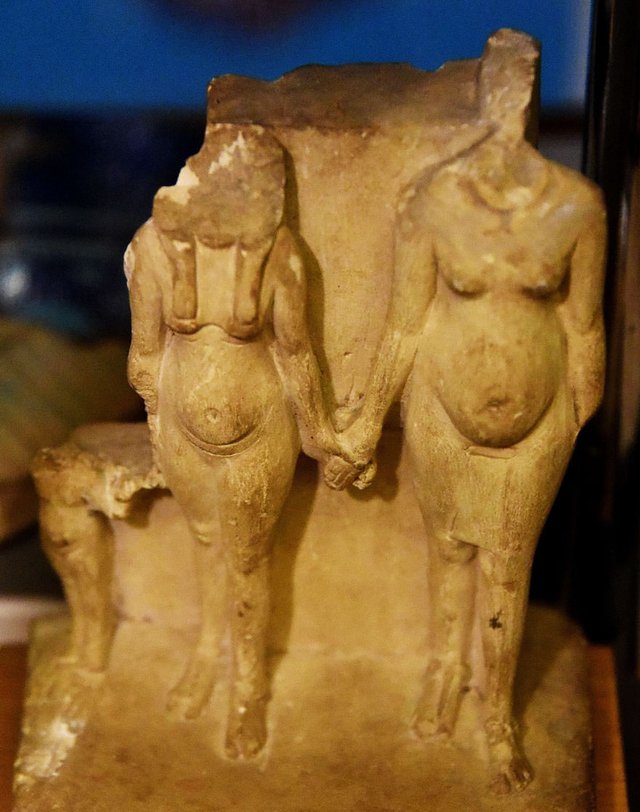
Some call the new style a "grotesque art", yet we still don't know why Akhenaten and his family showed up that way. Yet that kind of "courage" to appear naturally instead of following a strong formal style may have been an expression of uniqueness and the willing to "change everything to the core".
2. Amarna-Style in Images
The royal depiction on temple and palace walls underwent also a complete renewing. Before there was only the King that appeared as "the ruler over his people". Now the whole family is presented: Akhenaten with his wife Nefertiti showing up as a happy couple together with the kids while Aten in the shape of the sun disk with spreading many arms over them. You can see this in the picture below where the sunbeams end in some kind of flames or little hands kindly stroking the royal family. This is absolutely unique in the Ancient Egyptian art and can be seen as a tendency to develop a modern "image", but also expresses the equal position of the royal wife.
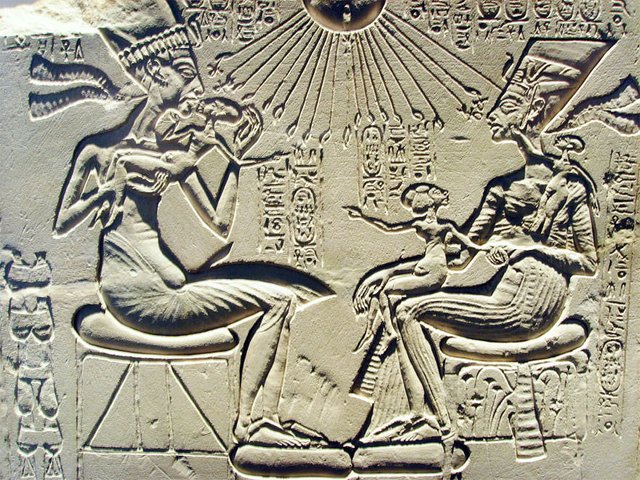
In the year 1337/36 Nefertiti suddenly died. We don't know the cause of her death but Akhenaten married after that a woman named Kiya, which is thought to be the mother of Tutankhamun.
3. Amarna-Style in Masonry
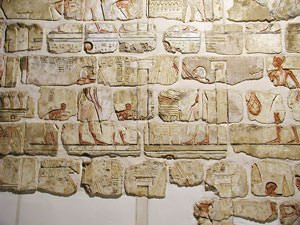
Img 7: Talatat Bricks (reconstructed)
Dead of the King and His Heritage
When Pharao Akhenaten died, probably in the year 1335/34 BCE, he left a country back that never got used to the new religious system. As mentioned above the priesthood of the old belief system wasn't happy about being replaced by priests of the Aten cult. So it doesn't surprise that the heritage of this king has become more of a "black hole" than something antecessors would like to remember in the following generations. Even his son Tutanchamun ("The Living Image of Amun"), which was born under the name Tutankhaten ("The Living Image of Aten"), changed back –beside his own name – almost everything his father invented. He returned to the Amun cult and re-installed the old priesthood.
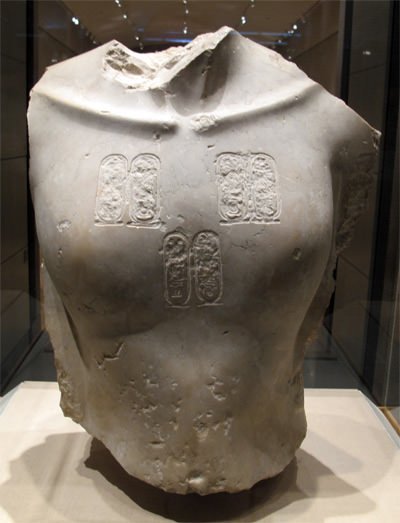
Img 8: Torso of Akhenaten's statue with destroyed name cartouches, Brooklyn Museum
The damnatio memoriae was a sign that Akhenaten did something that could not become popular because the spiritual and political environment didn't allow him to. The time for a monotheistic worldview was not right in his era, although the implementation of "one God" can be seen as a "vaccination" into people's mind. Just a few hundred years later the idea developed further and led to Christianity and other monotheistic religions.
Sources:
• https://www.livescience.com/39349-akhenaten.html
• http://www.samj.org.za/index.php/samj/article/view/5916/4347CachedMarfan
• Pritchard, James B., (ed.), The Ancient Near East – Volume 1: An Anthology of Texts and Pictures, Princeton, New Jersey: Princeton University Press, 1958, pp. 227–230.
• Schlögl, Hermann A., Echnaton, Verlag C.H. Beck, München 2008.
• Wilkinson, Toby, The Rise and Fall of Ancient Egypt. Bloomsbury Publishing 2011; pp. 289–290.
• Uphill , Eric P., Tell el-Amarna, City, in: Kathryn A. Bard (ed.): Encyclopedia of the Archaeology of Ancient Egypt. Routledge, London 1999, p. 763.
Images:
Image used in the editorial picture: Source
• Img 1: Source
• Img 2: Source
• Img 3: My own photograph
• Img 4: My own photograph
• Img 5: Source
• Img 6: Source
• Img 7: Source
• Img 8: Source
Feel free to ask all the question of what you always wanted to know about Ancient Egypt. That’s my job and my passion. Let’s discuss your thoughts and ideas.

If you liked this article, please follow me on my blog @laylahsophia. I am a german Egyptologist writing about ancient and contemporary Egypt, history of science, philosophy and life.
“It was the dead formalism of the Amon worship and the increasing arrogance of its enormously wealthy priesthood that Akhnaton intended to strike at. What he wanted was not to force onto his people a new religion of his own liking in the place of the old one, but to infuse into their hearts the genuine spirit of religion; to awaken them, from the routine of formulas, of symbols, of endless ceremonies, of which the original inspiration had long ago disappeared and the hidden meaning been forgotten, to the feeling of the Supreme Reality, through the rational worship of the living Sun.” – Savitri Devi
Another extremely interesting and informative post. Akhenaten is, most probably, the first influential ruler to promote "monotheism" but has disappeared from history.
This is one of the most interesting posts on the Steemit. I have a huge interest in ancient civilizations and would like to read more of this in your blog.
Thank you so much. Will keep you informed in the future. There is much more to read very soon. :)
Wow. Thank you. This is the kind of posts Steemit still lacks.
It's a pleasure. I wish I could write more often, but my job sometimes doesn't allow me to.
this called powerful research work. Egypt has the oldest colonies. Hope you will progress on your work.
Best of luck
Happy christmas
Egypt is home of wonders. it has vast history with itself. what a great country we have
Another perfect article! A single post and I already know so much about Akhenaten 👏👏
thanks your post .Egypt is very beautifull
thanks your post .Egypt is very beautifull